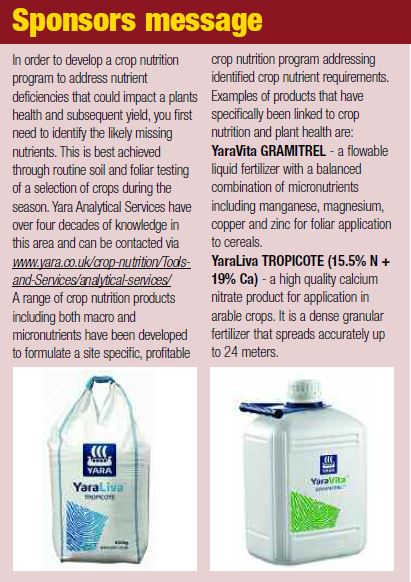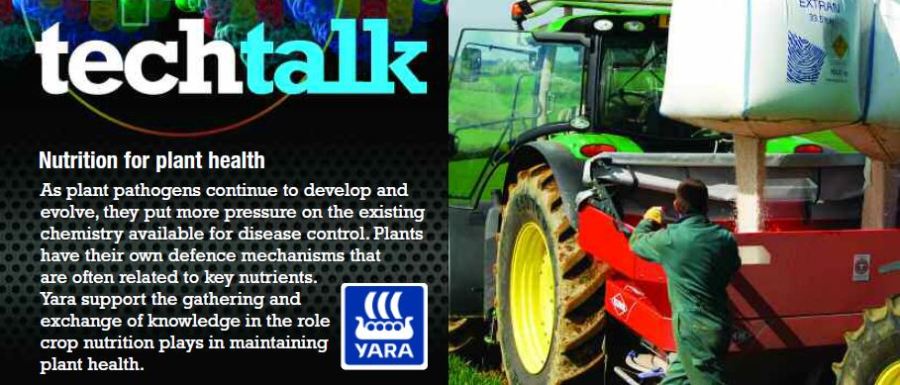
By Lucy de la Pasture
A balanced supply of nutrients will lead to optimal plant growth and also optimal resistance to disease.
When it comes to agronomy, the field of plant nutrition is a complex one, even though the principles on which it’s based are well established. In recent years, a more comprehensive approach to growing crops is something that’s now very much on growers’ radar; both by embracing precision techniques and adopting a broader focus on plant health.
Plants have their own ‘immune system’ and they respond to attack by pests and diseases by sending chemical messages which illicit a defence response. It’s at this molecular level that achieving a balanced supply of nutrients can make a huge difference to a plant’s ability to withstand stresses, points out Mark Tucker, Yara head of agronomy and marketing.
Why is balanced nutrition important?
Put simply, any imbalance in nutrient supply impacts on a plant’s ability to manage disease. Part of the problem is that this is inflicted by applying fertilisers at an incorrect rate or time.
Nitrogen and sulphur tend to grab the headlines because they have very visual deficiency symptoms but major

Over-supply of nitrogen leads to excess amino acids in plant tissues, creating a more favourable environment for pathogens to thrive.
nutrients are all important, with potash particularly influential when it comes to plant health.
A balanced supply of nutrients, in adequate quantities without causing antagonistic effects on other nutrients, will lead to optimal plant growth and also optimal resistance to disease.
Correct nutrition can make plants more tolerant, meaning they’re better able to maintain growth despite infection or pest attack; or more resistant to disease, which means they’re better able to limit the damage from infection or attack.
This better resistance is achieved by the plant’s ability to limit the penetration, development and reproduction of invading pathogens, or to limit feeding by pests. It does this as a response to chemical signals which may induce changes in cell wall thickness or the production of biochemicals with inhibitory or repellent properties.
What is the role of nitrogen?
An unbalanced supply of nitrogen increases susceptibility of plants to disease, but an optimal supply of nitrogen can
actually suppress disease.
Nitrogen is a key component of amino acids, the building blocks of proteins. Over-supply of nitrogen leads to excess amino acids in plant tissues, creating a more favourable environment for pathogens to thrive, particularly mildews.
As a further consequence of excessive nitrogen, the phenol content in plant tissues decreases. Phenols are antifungal, so the plant becomes more vulnerable to infection. The end result is a breakdown in the plant’s resistance to pathogen attack.

Ideally, a 10-day interval between plant tissue tests give a more accurate picture of the crop and the season.
Where root diseases, such as take-all, are a problem, nitrogen can aid a plant’s tolerance by creating rapid growth of root tissues to replace tissue lost through disease infection faster than the fungus can destroy them.
Optimum nitrogen levels vary from season to season, as well as from field to field, partly due to varying soil N levels, soil types and drilling dates. To help take this variation into account, precision techniques and decision support tools are useful to ensure its optimal supply.
How does potassium help?
Potassium acts as an enzyme regulator, so is involved in nearly all cellular functions that influence disease severity.
Water use in plants and potassium have the best known association. Potassium helps maintain turgor pressure by regulating the opening and closing of stomata in leaves, the openings which facilitate photosynthesis. So how does this relate to disease control?
Not enough available potassium reduces the efficacy of stomatal response, which means plants aren’t able to regulate water loss and wilting can occur. Because cell membranes have lost their integrity, leakage of cell contents occurs, providing pathogens with a ready food source. Not only is the plant now under water stress, making it less able to fight off disease, but pathogens can gain entry through stomatal openings.
Potassium is required for the synthesis of proteins, starch and cellulose, the key component of cell walls. If potassium supply is adequate then plants have thicker cell walls, resulting in a stem better able to withstand lodging. But a more direct effect on disease is the function of the cell wall as a mechanical barrier, which both helps resist invasion and infection by pathogens and keeps sugars within plant cells.
Inadequate supply of potassium leads to thinner cell walls and higher leakage of sugars into plant tissue, which stimulates fungal attack and germination of spores.
What about other major nutrients?
Phosphate becomes important to plant health when it’s under attack because it has a critical role to play in respiration. When the plant is fighting disease, its respiration rate increases, using more energy and requirement for phosphate increases. If phosphate is limited, then the plant is less able to switch on its own defence mechanism.
The balanced supply of sulphur to plants is important because of its interaction with other elements, such as molybdenum. If any more than 100kg/ha SO3 is available then excess sulphur locks up molybdenum, which is critical in nitrogen metabolism by plants. The result is excess nitrates in the leaves, a good food source for any invading microorganisms and perfect conditions for colonisation.
Calcium is another element integral to the structure and maintenance of cell membranes, so has a role to play maintaining a barrier to disease entry. A lack of calcium to newly formed cell walls leads to collapse and cell death, resulting in disorders, such as internal rust spot in potatoes.
How about micronutrients?
Micronutrients are only micro in that they’re required in much smaller quantities, but also have roles in biochemical pathways, such as lignin synthesis and phenol metabolism, essential for resistance to disease.
Boron is important in cell walls where it acts as a ‘cement’ between pectins holding the tissues together. Plants deficient in boron are more vulnerable to infection by mildew and fungal hyphae are better able to spread between plant tissues, so disease can spread quickly.
Manganese has a role in lignin formation but also in the production of phenols. Copper can have a toxic effect on microorganisms invading plant tissues and is also important in the production of fungus inhibiting compounds within the plant itself.
Zinc is utilised in nitrate metabolism and in the production of phenols. It helps prevent leakage of sugars from plant cells by maintaining plant membranes but a shortage of zinc leads to the accumulation of unused sugars in plants. This then causes leakage onto leaf and root surfaces, encouraging invasion by diseases.
How is availability monitored?
Soil is often used as the starting point when developing a nutrient plan but tissue testing is necessary to establish what’s happening within the plant. Sampling plant tissue needs to be more than a one-off measurement to give a more accurate picture of the crop and the season. Ideally, a 10-day interval between tests is desirable.
In the UK, there’s an increasing trend for an inadequate supply of copper and zinc, with deficiency often associated with a shortfall in supply of manganese. In 2016, 84% of Yara lab samples deficient in manganese were also low in both other elements.
How is it best applied?
Getting timing right is as important as getting quantities of nutrients in balance. Setting up the plant with an optimal supply of nutrients is an important component of the overall disease control strategy.
Nitrogen application is generally well matched to need but other major nutrients less so, with spreading of compound fertilisers in the autumn commonplace. Plants have the biggest demand for nutrients when they’re actively growing so phosphate, potash, magnesium and most micronutrients are best targeted at the Feb/March window.
If applied in the autumn, much of the phosphate will be locked up when the plant needs it and potash will have moved though the soil profile, below the rooting zone. Only hungry soils, where establishment is an issue, merit a percentage of phosphate and/or potash applied before the winter.
Zinc is an element which needs to be applied before the plant needs it because the damage is done if it’s in short supply. A split autumn/spring application is the best way to achieve this. A similar approach is advisable with boron, especially where crops with high boron demand, like oilseed rape, are being grown.
Nutrition focus is the game changer on Lincs brash
Lincs grower Robert Pask farms 376ha, near Grantham. Part of the Yield Enhancement Network (YEN), he’s keen to look at ways of improving his farming practices and maximise yield potential and profitability.
One of the factors limiting yields at Pask Farms is the soil type which he describes as limestone brash – it has a high pH and is apt to lock up nutrients so they’re not available to the crop.
“As easy as it is to establish crops on our soils, it’s difficult to keep the plant going towards the end of the season. If it becomes dry, then our crops really suffer and tend to show nutrient deficiencies late on,” he says.
“We’ve tried a number of approaches over the years to counter this. We’ve changed the timing of our main P and K applications to a small autumn dressing, followed by a main dressing in the spring so that it’s available when the crop needs it.”
But the main game changer has been the introduction of a foliar trace element programme for winter wheat and oilseed rape, now in its third year.
“We’ve been carrying out tissue analysis for several years and were picking up low levels of zinc, boron (which doesn’t show symptoms until May/June) and manganese,” he explains.
“We’re now applying zinc in the autumn and boron in early spring, which we follow up with a foliar trace element product at about the same time as applying fungicide.”
Robert Pask reckons this approach sets the crop up to stay healthy and yield well, which seems to be working as yields are generally on an upward trend.
“A couple of years ago, we were growing Santiago when other growers were reporting bad yellow rust in theirs. Our Santiago was clean at T0 and stayed healthy with a comprehensive fungicide programme for the rest of the season,” he says, attributing the difference to the nutritional support his Santiago was receiving.

“I’m convinced it’s what’s leading to improved plant health, less disease and an upward yield trend on the farm. We’ve tried a range of nutritional products but keep coming back to Yara’s product, generating a higher margin over costs in our on-farm trials where it always comes out better.”
Nutrition for plant health: top tips
- Know your nutrient levels – soil test but follow up by monitoring nutrient levels in plant tissue, ideally over a
period of time to get a true picture. - Maintain a balanced nutrient supply – for a healthy crop that’s set up to best resist or tolerate disease.
- It’s all in the timing – apply nutrients ahead of peak nutrient demand from the crop.




